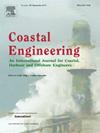波浪-水流复合条件下突发性植被沉积物再悬浮的阈值——水槽试验
IF 4.2
2区 工程技术
Q1 ENGINEERING, CIVIL
引用次数: 0
摘要
再悬浮的阈值可以用临界速度来描述。盐沼植被改变了水流条件,使得在裸床上得到的再悬浮临界速度不再适用。在植被冠层内,在纯水流和纯波浪条件下,再悬浮的临界速度先前被证明是降低的。在这项研究中,我们实验研究了在潮间带海岸线典型的波流联合流动下,新兴盐沼植被如何影响再悬浮。以米草属植物和细小的非粘性沉积物为灵感,在波浪流水槽中放置了新兴的人工植被冠层。我们设定一个恒定的电流,并逐渐增加波浪高度,直到测量到再悬浮。我们在裸床、三种干密度和一系列波流组合中重复了这一过程。植被引起的湍流显著降低了再悬浮的临界速度。茎部形成的湍流漩涡带走了河床上的泥沙颗粒。与裸床条件相比,再悬浮的临界速度降低了35-64%,这取决于当前速度与波速幅值之间的比率。在纯电流条件下,临界速度下降幅度最大,而在纯波条件下,临界速度下降幅度最小。最后,在植被存在的情况下,茎密度对再悬浮阈值没有影响。我们的研究结果可以通过调整植被床的Shields参数来实现泥沙运移模型,这可以用于盐沼的管理和基于自然的海岸保护干预措施的设计。本文章由计算机程序翻译,如有差异,请以英文原文为准。
The thresholds of sediment resuspension within emergent vegetation under combined wave-current conditions – A flume experiment
The threshold of resuspension can be described by a critical velocity. Salt marsh vegetation modifies the flow conditions such that the critical velocities for resuspension derived on bare beds no longer apply. Within vegetation canopies, the critical velocity for resuspension was previously shown to decrease under pure current and pure wave conditions. In this study, we experimentally investigated how emergent salt marsh vegetation affects resuspension under combined wave-current flows that are typical for intertidal coastlines. Emergent artificial vegetation canopies inspired by Spartina Anglica and fine noncohesive sediment were placed in a wave-current flume. We set a constant current and incrementally increased the wave height until resuspension was measured. We repeated this procedure with a bare bed, three stem densities, and for a range of wave-current combinations. The critical velocity for resuspension was significantly reduced by vegetation-induced turbulence. Turbulent vortices shed by the stems entrained sediment particles from the bed. The critical velocity for resuspension decreased by 35–64% compared to bare bed conditions, depending on a ratio between the current velocity and wave velocity amplitude. The critical velocity decreased the most under pure current flows and the least under pure wave conditions. Finally, with vegetation present, the stem density did not affect the threshold of resuspension for the range of densities tested here. Our results can be implemented into sediment transport models through an adjusted Shields parameter for vegetated beds, which can be used for the management of salt marshes and the design of interventions for nature-based coastal protection.
求助全文
通过发布文献求助,成功后即可免费获取论文全文。
去求助
来源期刊

Coastal Engineering
工程技术-工程:大洋
CiteScore
9.20
自引率
13.60%
发文量
0
审稿时长
3.5 months
期刊介绍:
Coastal Engineering is an international medium for coastal engineers and scientists. Combining practical applications with modern technological and scientific approaches, such as mathematical and numerical modelling, laboratory and field observations and experiments, it publishes fundamental studies as well as case studies on the following aspects of coastal, harbour and offshore engineering: waves, currents and sediment transport; coastal, estuarine and offshore morphology; technical and functional design of coastal and harbour structures; morphological and environmental impact of coastal, harbour and offshore structures.
 求助内容:
求助内容: 应助结果提醒方式:
应助结果提醒方式:


